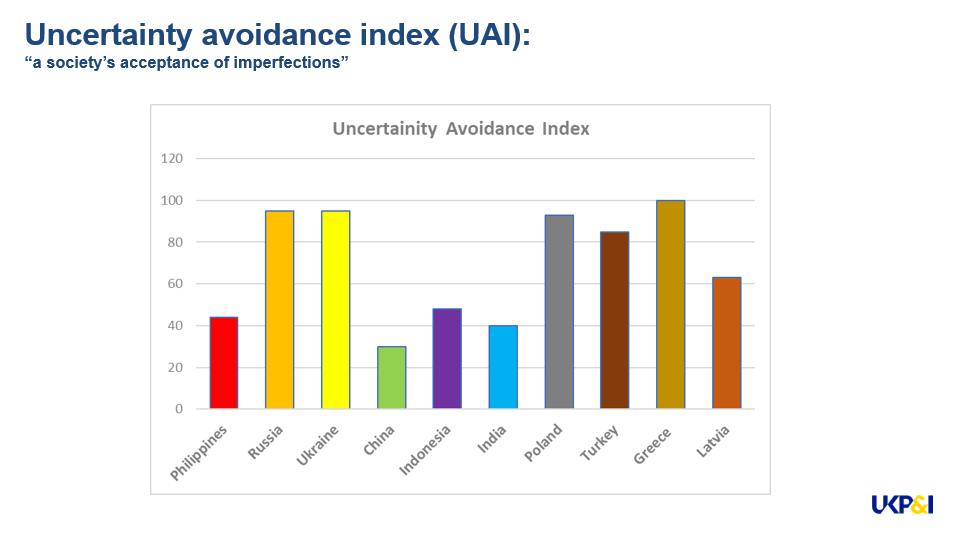During the 2023 SAFETY4SEA Athens Forum, Capt. Konstantinos Karavasilis, Regional Director, Loss Prevention, UK P&I Club, gave a presentation on how power distance affects communication, decision making and leadership styles.
Understanding power distance
Looking at statistics from the number of crew injury files opened during 2022/2023 Policy Year at UK P&I Club, two major causes appear as the reason behind crew the 610 accidents. First, a lack of situational awareness and, second, in many cases, power distance.
Power distance signifies the extent to which individuals in a society accept and anticipate unequal distributions of power. It’s a concept that helps individuals understand how people relate to authority and hierarchy in different cultures and organizations. Power distance has a major impact on different aspects including the following:
#1 Communication
In high power distance cultures, people may use more formal language and show deference to authority figures. In contrast, in low power distance cultures, communication tends to be more direct and informal. Recognizing these differences can aid in effective communication with people from diverse backgrounds, such as the crew onboard a vessel.
#2 Decision-making
In high power distance settings, decisions often come from the top down, and subordinates may not feel comfortable offering input. In low power distance settings, decision-making can be more collaborative, with input from various levels of the organization.
#3 Leadership styles
Leaders in high power distance cultures may be seen as more authoritative and distant, while leaders in low power distance cultures may adopt a more participative and approachable style.
In high power distance settings, decisions often emanate from the top down, inhibiting subordinates from contributing their insights. Conversely, low power distance cultures foster collaborative decision-making, incorporating input from various organizational levels.
For instance, borrowing from the iconic Star Wars narrative, Darth Vader, and Luke Skywalker, two iconic characters from the Star Wars saga, exhibit vastly different leadership styles, which respond to a high and low power distance accordingly.
High power distance is evident in Vader’s leadership style. He believes in the concentration of power at the top and expects unquestioning obedience from those beneath him. On the contrary, Luke’s leadership style exhibits lower power distance. He sees value in shared leadership and believes in empowering others rather than asserting dominance. So, maybe, Vader’s approach to leadership was one of the contributing factors to his defeat.
Cultural insights from research
Referencing cross-cultural research by Dr. Geert Hofstede, the presentation provided insights into power distance indexes of different nations. It is now well recognised across the globe as a standard for understanding cultural differences.
Dr. Geert Hofstede, a psychologist, published his cultural dimensions model at the end of the 1970s, based on 10 years of research in which he investigated power distance dynamics in several nations. He also introduced the Power Distance Index (PDI), which refers to the extent to which the less powerful members of organizations and institutions accept and expect that power is distributed unequally.

Using Greece as an example, with a PDI of 60 the country has an intermediate score, but it indicates a slight tendency to the higher side of PDI – i.e. a society that believes hierarchy should be respected and inequalities amongst people are acceptable. This could also mean that Greek people are often biased that people who hold power are more often right.
The different distribution of power justifies the fact that power holders have more benefits than the less powerful in society. In companies it is not uncommon for one boss to take complete responsibility. It is not surprising that Greek people often carry this attitude and mindset onboard vessels.
Scandinavian countries, on the other hand, exhibit lower power distance indexes, indicative of more egalitarian beliefs.
Ambiguity avoidance and cultural influences
Ambiguity avoidance and its manifestation in different cultures also has a major part to play in how power distance dynamics are formed. At 100 Greece has the highest score on Uncertainty Avoidance which means that as a nation Greeks are not at all comfortable in ambiguous situations: the unforeseen is always there ready to “lay an ambush”.

In Greece, as in all high Uncertainty Avoidance societies, bureaucracy, laws and rules are very important to make the world a safer place to live in. The Greek myth about the “birth” of the world tells us a lot about high Uncertainty Avoidance: at the very beginning there was only Chaos but then Cronos (Time) came in to organize life and make it easier to manage.
However, studies have shown that mixed cultural teams often work well together, as they question attitudes and assumptions, beliefs and provide a safer environment. But communication can be an issue.
Improving communication and understanding through soft skills training
Communication is difficult even without culture, the leader is in the middle and needs to communicate with many different people and organizations. Culture makes this foggier, communication may be weakened, misunderstood, or even ignored.
A way that communication can be facilitated is through soft skills training. Instead of solely focusing on technical knowledge, seafarers could also greatly benefit from learning how to understand their colleagues and what language they should use in each environment in order to foster open communication.
At a glance
In conclusion, power distance and its multifaceted impacts on communication, decision-making, and leadership styles underscores its pivotal role in shaping the dynamics within diverse cultures and organizations. As a result, eliminating power distancing through the development of soft skills is essential for fostering safer and more effective ships.
The views presented are only those of the author and do not necessarily reflect those of SAFETY4SEA and are for information sharing and discussion purposes only.
Above article is a transcript from Capt. Konstantinos Karavasilis’ presentation during the 2023 SAFETY4SEA Athens Forum with minor edits for clarification purposes.
Explore more by watching his video presentation here below



































































